Abstract
The principle point of this study was to evaluate the relationship between service quality and client maintenance in fast food outlets. The paper checked in the past and current writing to introduce the hypotheses. This study utilized both essential and optional information. Essential information is whereby the analyst gathers direct data which does not as of now exist in any structure. The essential information was gathered from a sample of 200 members utilizing questionnaires. The auxiliary information involves the utilization of the current information or data. Optional information was utilized as a part of the writing survey, whereby the past information/data was utilised to exhibit the speculations of this examination. The information was examined utilizing different measurable strategies. The outcomes uncovered that most of the members concurred or firmly concurred that quality service made them come again and again to the nourishment outlet. Four measurements emphasise the level of client maintenance. These measurements are levels of mindfulness made by the nourishment outlet, the nature of service/sustenance, the steadfastness of the clients to the nourishment outlet, and the picture of the sustenance outlet.
Introduction
Background information
Many studies have uncovered the developing patterns in expanded hobbies to feast far from homes. The increment in these intrigues means the different way of today’s era. Fast food outlets much of the time is frequented by youthful and advanced people. Also, the level of rivalry among the outlets has expanded inside of the business. The clients who decide to eat at a top of the line fast food outlets as a rule like to experience an aggregate eating dream. Understanding the desires of the clients by the eatery proprietors is sufficiently important to help in settling on choices to pull in and hold distinctive identities of the clients.
Regardless, the accessible writing basically concentrating on what inspires the clients to successive nourishment and drink outlets are exceptionally constrained. This study, along these lines, expects to propel the restricted research in this field and produce new recognitions concerning the decision and inclinations of the buyers.
Fast food restaurants
All around, the speed of living has heightened; this has called for shorter eating hours. The quick development of fast food business has been upheld by this. Eating out in sustenance outlets does not just fulfil the coffee shops’ appetite. It likewise adds to the coffee shops’ pleasure, excitement, mingling, and individual comfort. A legitimate business procedure for the fast food outlets is so valuable. This serves to comprehend the arrangement for the needs of the clients. The technique is as far as the eatery’s picture, top notch administration, fitting arranging, et cetera. The eatery’s picture is exceptionally appropriate in adding to the achievement of the fast food business because of the way that it makes client dependability and trust. Numerous clients like to be related to a particular outlet where they get a brilliant administration (Aaker 1991, p. 26).
Fast food eateries are well known among youthful individuals. These eateries offer foodstuffs which are less expensive and are served rapidly. A large portion of these regulars is lone rangers or old maids with restricted duties. In this manner, they lean toward a speedier fix. The sorts of nourishment here are fish fries and chicken fries among others, and they are ordinarily arranged quicker and served rapidly. The fast food business is increasing much ubiquity globally because of the way that it is vastly different from the typical eatery business; the foodstuffs are less demanding and quicker to plan. Moreover, a client can eat and work or participate in another distinctive action all the while when utilizing fast food outlets (Keller 1993, p. 108).
Four measurements focus the level of client maintenance. These measurements are the level of mindfulness made by the eatery, the nature of the administration, the dedication to the eatery, and the picture of the eatery. These four measurements will be investigated in this study. The impression of the clients regarding an eatery will be attached to the four measurements. Every measurement has a different impact on the client’s capacity to return to the sustenance outlet again and again.
Because of the way that there is expanded rivalry and quick paced changes in the worldwide business sector, numerous sustenance outlets have viewed the nature of administration as the best objective. In a genuine sense, the eatery proprietors think that it is difficult to deal with their quality of service because many fast food outlets serve the same meal. They, accordingly, fall back on setting cheaper prices as the top most technique for drawing in clients. Giving rebates to clients is viewed as the most helpful method for drawing in and holding clients. Yet in the meantime, it baffles the business as it understands low benefits (Aaker 1991, p. 27).
Existing writing recommends that a fitting administration of eateries is financially gainful. Numerous organizations have turned to fitting eatery business administration to make an engaging attention to clients who are the principle target. At the point when mindfulness has been made, the clients will be faithful to a specific nourishment outlet so as to have a feeling of acknowledgment or picture. This study, in this way, investigates the relationship between the quality of the service and client retention.
Problem Statement
There is a critical requirement for the eatery proprietors to sort the needs of their shops because these needs are vital to make decisions. They utilize this data to make preparations enough for the supplies of their contribution and implementation of their techniques. Data about customer conduct is likewise extremely significant to the eatery administrators as it helps them to comprehend the way of the aimed business sector (Doyle 2002, p. 123).
Numerous individuals have of late favoured dining away home instead of dining at home. With the expanded number of eating outlets, rivalry on the nature of nourishment administration has gone up, coming about to enhanced quality guidelines. The food outlets must be imaginative and increase the value of the quality that they as of now have. Different studies have uncovered that families’ spending on food outlets has gone up. With the increment sought after for nourishment far from home, numerous eateries have come up (Jones & Slater 2003, p. 163). The eatery proprietors have a tough undertaking to fulfil the flow sought after by the shoppers.
The numerous eateries settle on the choice to be innovative in an unexpected way, and these choices impact the shopper’s inspiration to return and visit the eating outlets over and over. The sorts of choices that are made include the nature of sustenance, the vibe of the eatery, the nature of the administration, and the mixed bags of the nourishments that are provided. This shifts from one eatery to the next. Cafes ordinarily consider the early introduction or experience very and they utilize their judgment to settle on eating choices (Doyle 2002, p. 122).
Research Objectives
This paper intends to achieve some number of goals, which include:
- To evaluate the relationship between service quality and customer retention, and
- To assess the impact of high service quality on customer satisfaction.
Research Question
The above research objectives will be assessed by taking into consideration the following research question.
What is the impact of the level of the quality of service on customer retention?
Research Hypothesis
The paper is based on the following null (H0) and alternate (H1) research hypotheses to achieve the research objective.
- H0: High service quality directly correlates with higher customer retention.
- H1: There is no correlation between high service quality and high customer retention.
Justification of the study
This study is essential because of the way that it builds onto the accessible group of information with respect to the components that persuade the clients to be attached to nourishment outlets. The after effects of this study are exceptionally important to the fast food proprietors in light of the fact that they can utilize it for organizing purposes, so they can think of obvious destinations to pull in and hold an extensive client base.
Literature Review
This section surveys the speculations both experimental and hypothetical that are firmly connected with comprehension the relationship between administration quality and client maintenance.
Overview of Customer Service
Definition of Customer Service
A customer is someone who has bought a product, idea or service from a company, seller or supplier (Bell 2005). However, from the view of customer satisfaction the explanation for the customer should add the person, who uses services from the company directly or indirectly. That is more likely to presume anybody who might buy any product or service to be a customer. The company needs an action to deliver their products to customers; this kind of action is usually called a service. Services have many types; they are based on the type of product and organizations. In different domains, service can be defined in many different patterns. Service is an invisible operation or performance, it differs from one organization to another organization and it does not change any ownership (Bennett & Rundle-Thiele 2002, p. 200).
Customer service has five features. First of all is Intangible. Service happens in any time when a customer is in contact with the company. The service is different from time to time. In addition, service is very hard to price; it is affected by many constraints. For example, the staff communication skills, how many times to wait for service and so on. The second feature is coexistence. When a service happens, it might persist for several seconds or for a long time. However, it always affects both the customer and the service producer. The third one is new products and new distribution channels. Service is delivered in many ways, such as the internet, telephone and retail store (Berman & Evans 2006). The fourth feature is heterogeneity and unique variation. Service is intangible, special and irreversible. Therefore, it is hard to apply a service on commodity responsibility or customer protection. The last one is Creativity. Every service situation is personal and needs many spaces for the service provider to exert (Blanchard & Cathy 2002). Because of economic changes, consumers do spend less money or change some consumer habits. Restaurants realize service quality has a very important effect on retaining and gaining customers (Britton et al. 1999, p. 27). Companies want to keep customer service to be a very high level, but it is a desirable value.
Customer Service Quality
The definition and measure of service quality are very important for managers. When the management wants to increase service quality, an explicit definition will give great help. In one business, the customer usually searches for both quality and service. Quality means the characteristics and features of a product or service, which more or less fit the customers’ clear or unclear demands (Holt & Quelch 2009, p. 70). Quality can affect customers; they will use it to judge the deal. In the manufacturing businesses and service businesses, quality has different characteristics. It is very difficult to define service quality in service businesses because it has two characteristics, for instance, concurrency and intangibility (Hong, Thong & Tam 2005, p. 156). Service quality at a phenomenal range depends on the customers’ expectations and perceptions. As a result, different customers can have different perceptions of the same service. One might think it is great while the others may feel it needs improvement. In other words, the customer’s perception is determining the factor of service quality (Hoq & Amin 2010, p. 2387).
Many works of literature have described the service quality as the perceived quality of service. Perceived quality of service means the comparative result between the consumers expected service experience and their actual experience of service. The direction and magnitude of the perceived service quality come from the distinction of the consumer’s expectation and their rated experience (Hughes, Ginnett & Curphy 2012). Service quality is a level of administration coming to the shoppers’ prospects or not. It could be great or poor. The clients’ desires and view of administration will focus the nature of a service. In the event that the given service does not meet or surpass the desires of the client, then the administration quality will be seen to be flat. In case it does surpass the desires, then the service quality will be seen to be high (Jamali 2007, p. 377).
The quality of service is fundamental in pulling more clients to a business. Numerous clients will feel great to be connected with magnificence (Jerisat 2004). The clients ordinarily have their desires before using a service. Ordinarily, the clients anticipate that their desires will be met (Jewell 2011). Service quality embodies three components, for example, physical facilities, procedures, and techniques. The second component is the individual conduct with respect to the serving staff. The third component is the expert judgment with respect to the serving staff to get the great quality service (Jha 2014). What constitutes a suitable blend will be dictated by the relative degrees of the work-force, service process customization, and interaction and connection between the client and the service procedure.
Restaurant staffs are part of the restaurant’s product; they have enormous influence on customer satisfaction and retention. Other researchers also presented that the employee’s action and behaviour are the key points of customer satisfaction and service quality (Johnson 2008, p. 87). Employee’s skills, service attitude, and work efficiency may have an influence on the service quality. Creative employees also create the basis for the hotels’ competitive advantage, because service quality and customer satisfaction are influenced considerably by the values and actions of such employees (Kandampully & Suhartanto 2000, p. 348).
Customer Satisfaction
Customer satisfaction includes two aspects, the antecedents of customer satisfaction and the consequence of customer satisfaction. Satisfaction is not a feeling at a particular time, it is the cumulative satisfaction which starts from the first time the customer uses a product and extends through the whole service period (Kang & Singh 2006, p. 197). Every company should make customer satisfaction as an important goal because satisfied consumers will use the product again (Kantabutra & Avery 2010, p. 42). Actual care and appreciation of the consumer is significant for the firm. It is clear that if a customer is offered some good service, he/she is more likely to return again.
The consumers might also let their friends know about the great service they got. Satisfied consumers are not only given a good experience to customers, but also save funds for marketing expenses. People have a relationship network, and they usually share the special experience of from their lives. That is why the marketing community needs focus on the consumers. Companies have to know their consumers feeling when they are using the product. They also need to know the competing firms and make the necessary improvements (Karamitsios 2013). Many managers believe that satisfying the customers is important for business.
Customer retention and loyalty
Customer retention is the act of keeping profitable customers, and making sure that they do not defect. This will stop the competitors from getting profitable customers (Reynolds & Arnold 2000, p. 92). A retained customer is a customer who has a permanent relationship with a company (Reynolds & Valentine 2011). Customer retention in some research is called customer loyalty. Customer retention is the dependent variable in our model in view of its value as a surrogate for customer loyalty and its well-proven contribution to profitability (Roth 2008). Customer loyalty represents the assurance that the customer will only utilise a particular product or service. Normally, this happens when the customer has experienced a quality service (Roy 2012).
Customer loyalty, the main consequence of customer satisfaction, has been defined and measured in many various ways over the past decades (Rust, Zeithaml & Lemon 2004). According to the literature on loyalty, customer loyalty has several distinct dimensions. The two most important dimensions are behavioural and attitudinal components (Saili, Mingli & Zhichao 2012, p. 4299). Customer loyalty is behaviour. Behavioural loyalty signifies actual repeat purchasing behaviour or the likelihood of repeat product and service purchases from the same supplier. However, other research defined customer loyalty as an attitude; it includes affective and cognitive components (Saxena 2012, p. 40). Using this perspective, customer loyalty is perceived as the future intention-to-repurchase or commitment that reflects the cognitive and emotional attachment associated with the product.
The concept of consumer behaviour
Consumer behaviour
An understanding about the conduct of the customers is extremely helpful in getting ready for the buyer based administrations. Accordingly, it is less demanding to bring up the impression of the purchasers toward a specific item. Customer conduct can, along these lines, be clarified as the methods that shoppers seek after when trying to purchase or inspect an item or an administration that is intended to experience their cravings (Sekaran 2010). Turley and Moore sorted the conduct of the buyers into two. These include subjective customer conduct and shopper conduct fixing to the purchaser’s experience-arranged. The contrast between the two is that psychological buyers are judicious while experienced purchasers have an individual connection to the commodity or the service (Turley & Moore 1995). Subsequently, they portrayed four distinctive qualities of a customer. The attributes are consistent, taught, guiltless, and social (Turley & Moore 1995).
Intelligent shoppers will need to have a decent learning about the item or administration in addition to the included components before making the move to purchase it. By diving into the data about the item, an affiliation or disposition between the customer and the item/administration is produced. It is this affiliation/state of mind that will figure out if the purchaser will purchase the item/benefit or not (MacDonald & Sharp 2000, p. 10). In connection with this study, numerous clients are voyagers; they would wish to know all the more around an eatery and build up a state of mind/connection to the eatery before going to eat out. Intelligent buyers can, in this way, be abridged in three stages, for example, having knowledge, developing an attitude and executing the action of purchase.
Honest buyers, then again, first develop a state of mind/affiliation towards the item/benefit. It is the state of mind that will drive them to look for more learning or data with respect to the item. In the wake of getting the information, they settle on a choice with reference to whether to purchase the item or not (Ladhari, Brun & Morales 2008, p. 569). In the setting of this study, clients have a tendency to be affected by their companions or partners to add to a state of mind around a specific eatery. After that, they get to be interested to know all the more about the items and administrations in that eatery before proceeding onward to make the buy. Honest customers can, in this way, be condensed in three stages, for example, developing a state of mind, having knowledge and executing the action of purchase.
Taught customers get their conduct from normal propensities. Their acquisition of an item is unconstrained; they don’t plan to make an acquisition as a result of their decision. An immaculate sample is a shopper who buys a daily paper. He will first buy the daily paper, become more acquainted with the data about it and after that builds up a demeanour/relationship with the daily paper. Their conduct can be compressed into three stages, for example, executing the action of purchase, having knowledge and then developing a state of mind. The last classification is the buyers who are affected by the social environments in which they work in. They regularly settle on a choice to buy an item/benefit as a consequence of the sort of way of the life that they live in, or as an aftereffect of their economic well-being. Their conduct can likewise be outlined into three stages, for example, executing the action of purchase, developing a state of mind and having knowledge. The inspiration of the buyers/client is affected by various variables, for instance, the way of life in which the customer is connected with, the status of the purchaser in the general public, the age, financial status and the profession of the customer, lastly the demeanour, observation and convictions of the shopper (Kotler et al. 1999).
The purchasing propensities for the shoppers
The buying propensity for a customer is fixed to his essence of the item, the view of the item, and his way of life. The purchasing conduct of the purchaser is impacted by various inward and outer components; this makes it an intricate marvel inside and out (Simon 2007, p. 128). The buying propensity for the customer is separated into five stages as shown in Figure 2.1.
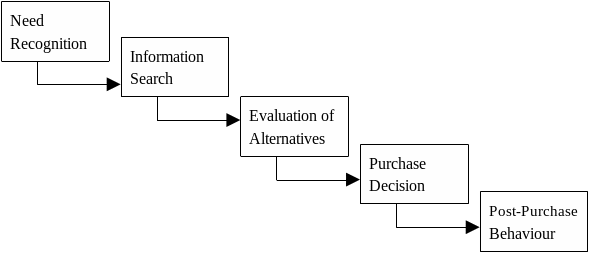
Service quality and customer decision
It is vital that nourishment outlets must have an unmistakable picture of what the client anticipates from them (Josiam & Monteiro 2004, p. 22). The customers’ decision on the nature of a service is altogether different from their decisions as to picking an item. This is an account that services are a great deal more unique in relation to the products. Merchandise is substantial and can be touched while services cannot be touched. A product is perishable but service is not (Sirdeshmukh, Singh & Sabol 2002, p. 28). Subsequently, these defy the clients when looking at services and items. Dissimilar to commodities or items, service cannot be touched, or tasted, or seen (Aaker 1991, p. 67). The clients are known to make decisions in light of both substantial and immaterial variables. Measurements like the nature of the nourishment or administration, and the cost of the item in connection to the administration are a few cases of immaterial variables that impact the choice making procedure of the purchasers (Asp 1999, p. 290).
The eatery proprietors typically pick to focus on unmistakable variables that are known for impacting the clients’ choice-making. The substantial measurements that they embrace are the great climate of the eatery, decision of music and sound level, enhanced offices, and so on (Auty 1992, p. 330; Bailey & Tian 2002, p. 60).
Service shifts from one supplier to another and from a client to another (Bailey & Earle 1993, p. 262). Because of this variability, purchasers have a tough assignment to settle on choices to pick one provider over another. The eatery proprietors additionally have a tough assignment of keeping up a relentless level of operation as far as the nature of the food or service (Sivadas & Baker-Prewitt 2000, p. 76). Case in point, if an eatery server/server gets a protestation from a client, the grumbling will impact him/her to give low-quality administrations hence (Kotler et al. 1999).
An eatery proprietor will measure the productivity of the service strictly when he/she has sold it. Then again, a client will gauge the proficiency of the service when he/she has purchased it (Kivela, Inbakaran & Reece 2000, p. 22; Kivela 1997, p. 120). The level of a polished methodology of the eatery workers will give the clients a knowledge concerning the administration quality. In the same connection, the criticism or reactions got from clients will give the eatery proprietors an observation with respect to the clients’ fulfilment in regards to the eatery’s administration (Srinivasana, Andersona & Ponnavolub 2002, p. 45). Clients can buy physical items at any given time because of the way that they can put away and sold whenever the client gets some information about their accessibility. Then again, it is unrealistic to keep a service.
When the customers do not buy a service, then the service does not exist in any case (Kotler, Bowen & Makens 1998, p. 253). Restricted of outlining this is to take, for a case, a client who has reserved a spot and neglects to appear. The eatery will neglect to serve different clients when the eatery turns out to be full on the grounds that they are reckoning the entry of the client who held the table. Because of the way that the way of the clients is dubious, the eatery proprietors think that it is testing to discover the harmony between the supply and interest for their administrations (Stecher & Rosse 2007, p. 781).
How consumers make decisions
A lot of researchers have developed diverse understandings of the model of choice making by the customers. This model gives a clarification of the strides that any customer takes subsequent to seeing the item up to the time he/she settles on the choice to buy the item. Because of the way that services fluctuate from one eatery to the next, the procedure by which customers settle on their choices regarding utilizing a service is far very different from the procedure by which they settle on their choices when acquiring a commodity. Ladhari, Brun and Morales thought of a five-stage model of the buyer choice making procedure (Ladhari, Brun & Morales 2008, p. 570). The procedure begins with the need acknowledgment whereby the buyers characterize their needs. The needs can be made because of both inner and outside variables. An illustration of an inside variable is the point at which the buyer chooses to dine on the grounds that he/she feels hungry.
A sample of an outside variable is the point at which the need of the buyer is made when he sees an advert around an item. It is essential for eatery proprietors to be acquainted with the elements that catch the hobbies of clients. These needs can be identified with a setup of an eatery. The mental needs of the clients will inspire them to utilize a specific eatery. The eatery proprietor then treats the clients with a decent quality administration which gives them a feeling that they are in the right place and secure. Likewise, clients like to pick a specific eatery that is in accordance with their standard; in this way, giving them a status in the general public (Miller 1993, p. 48). The buyer recognizes the way that, in fact, there is a need present. The need drives the customers to discover answers (Johns & Pine 2002, p. 132). Maslow added to a progressive system of human needs. These needs were positioned by Maslow according to their hierarchy.
The next stage is the search for information. In this stage, the customer is spurred to know all the more about the service. Then the shopper assesses the accessible existing options whereby he can think about costs and quality. The shopper then settles on the choice to make the buy. The buyer will gauge their prospects about the item/benefit against the execution of the item in the post-purchase stage (Kotler et al. 1999). The information can be pursued from companions, partners or even the press (Su 2004). Sensible customers will need to have a decent learning about the service in addition to the included components before making the move to purchase it. By diving into the data about the service, an affiliation or state of mind between the buyer and the service is created. It is this affiliation/state of mind that will figure out if the customer will appreciate the service (Lovelock, Patterson & Walker 1998, p. 251).
After that the customer checks if there are other substitutes of the service. At the point when a client has recognized a need and has sufficiently assembled data about the need, he/she will search for other conceivable alternatives that exist with respect to the class of the need the client has. In this case, the client will investigate the different qualities of the need to help him/her settle on a choice (Brookes 2004, p. 162). In the setting of an eatery, the particular traits that are investigated by the client incorporate the choices of food offered, the costs, the essence of the food, and so on. This clarifies the essential motivation behind why one eatery is picked over another (Kotler et al. 1999). The next stage is the purchase of the service. After the effective thought of the main three stages, the client will make his/her mind buy the service from the favoured seller and expand it. In the setting of an eatery, the procedure of procurement and utilization are integral; they happen together. At this stage, the client is exceptionally certain in light of the fact that he/she has enough and significant data about the administration (Kim 2000, p. 49; Hoffman & Bateson 2001, p. 26).
The fifth stage is the assessment of the service after the consumer buys it. Fast food administrators are obliged to have as a top priority this procedure of choice making with a specific end goal to know and comprehend what the customers’ requirements are in every stage. This will likewise help them in making valuable methods sooner rather than later (Jackson, Titz & DeFranco 2004, p. 23). Balanced buyers will need to assess if their desires have been fulfilled by the administration after buy and utilization. At the point when the client is fulfilled, he/she is liable to settle on the eatery the top decision. The client is likewise liable to end up exceptionally faithful to the eatery and elude a companion to the same eatery. In future, the client won’t feel disturbed to pay more for the service on the grounds that he/she has full certainty (Ladhari, Brun & Morales 2008, p. 568).
How consumers choose fast food outlets
As per the past investigations of the same, different researchers thought of the distinctive elements that impact the purchasers’ choices before selecting eateries. Mill investigated what impacts the choices of a client and figured out that the nature of sustenance and the feel of the eatery assumed a major part in affecting the clients’ choices (Mill 2007, p. 68). Dugan likewise figured out that the choices of the customers are impacted for the most part by the picture of the eatery and what other individuals say in regards to the eatery. Furthermore, he discovered that the more established individuals like calm spots with a decent feeling and delicious nourishments. More youthful individuals, then again, favour eateries that give snappy foodstuffs reasonable costs (Dugan 1994, p. 82).
A lot of clients are completely fulfilled by the eatery if the costs are reasonable and the sustenance quality is great. The clients will have a justifiable motivation to return to the eatery and even prescribe the eatery to a companion (Auty 1992, p. 325). The customer’s process of choice-making process by is likewise influenced by the impact of others. A client can choose to pick a specific sustenance outlet in light of the fact that his/her companions typically visit there. The clients typically have a propensity for trading thoughts with their companions in regards to new nourishment outlets that have come up keeping in mind the end goal to get their recommendation. At the point when a nourishment outlet is respected exceedingly by companions, the client is well on the way to lean toward it. Publicizing likewise impacts the choice making procedure of the clients. It makes more mindfulness about the item since it is the greatest type of correspondence (Aaker 1991, p. 65). Different variables incorporate the bundling of the administration and the comfort of the administration (Bailey & Earle 1993, p. 262).
Numerous clients are respected to be sound purchasers. They first need to have information about the item, create and state of mind before continuing to make the buy. Their choices to buy are affected by both interior and outer components. The primary component that propels the clients is the nature of the sustenance or administration. Any given brand stems its character from its quality. The purchasers, in this manner, give careful consideration to the service quality that is accessible (Aaker 1991, p. 120). The clients typically take a glimpse at the cost of the item or administration as another element that impacts their choices to pick a sustenance outlet. Cost and quality are correlative, in that, the most astounding quality pulls in the most elevated costs and the other way around. Numerous fast food outlets have brought down their costs to upgrade their focused edge in the business; therefore, decreasing their monetary dangers (MacDonald & Sharp 2000, p. 10; Szymanski & Henard 2001, p. 32).
A lot of researchers have investigated the variables that impact the decision of a nourishment outlet. A lot of elements have been named; however, there are four variables that truly emerge. Different studies have distinguished the nature of the service as a top variable. Furthermore, the nature of the food has likewise emerged to be a top variable. These two variables have a momentous impact on the fulfilment of the client. Furthermore, they affect the post purchase conduct of the client (Ennew & Binks 1996, p. 220; Finkelstein 1989, p. 33; Goldman 1993, p. 68). A lot of studies have indicated that food quality is exceedingly related to the satisfaction of the client. Then again, different studies have likewise indicated that the service quality is exceptionally connected to the general inclination of the client (Dube, Renaghan & Miller 1994, p. 42). Buyers, consequently, settle on their decisions in accordance with the elements of food and service qualities.
Numerous studies investigating on what impact the clients’ choices to pick a food outlet have distinguished food quality as a top variable (Wal, Van & Bond 2002, p. 330; Dillman 2007, p. 48; Cowell 1989, p. 79). The food quality has different measurements that level-headed shoppers regularly take a gander at. These measurements incorporate the essence of the nourishment, the collection of foodstuffs, solid sustenance and familiar foodstuffs. The essence of the food has a quick impact on the customer’s choice to pick an eating outlet. It is the most critical measurement of nourishment quality (Kim & Geistfeld 2003, p. 73; Keller 1993, p. 10). The principal motivation behind why clients decide to eat out is to empower them to have food that they can’t have in their homes. In this way, the essence of the foodstuff and the method of preparation are essential (Kelly & Carvell 1987, p. 64).
The clients regularly incline toward an outlet with a wide choice of foodstuffs in their menus. Clients discover eating in an outlet with a restricted choice of foodstuff to be dull since they eat the same kind of nourishment constantly (Kelly & Carvell 1987, p. 64). A wide mixture of foodstuffs in the menu is an imperative viewpoint that the clients take a gander at acutely. There is a developing pattern by numerous clients everywhere throughout the world to mind their well-being by deciding to eat foodstuffs that do not meddle with their body framework, for example, older people typically want to eat nourishment with negligible levels of cholesterol (Hassan & Hall 2004, p. 92; June & Smith 1987, p. 24). As to this, many eateries have overhauled their menus to catch the medical advantages of the sustenance with a point of pulling in numerous clients who are enthusiastic about adhering to a good diet. It is because of the component of wellbeing that will drive a client to lean toward Chinese cuisine, or Indian buffet, or whatever other ethnic nourishment because of the broad conviction that they are solid nourishments (Heung, Wong & Qu 2000, p. 88).
Numerous clients originate from differing societies and there are some particular foodstuffs that fit them. It is the obligation of the eatery proprietors to comprehend the way of life of the clients and offer them recognizable foodstuffs with well-known fixings (Greenbaum 1998, p. 83). Clients will dependably incline toward eateries that offer them natural nourishments (Gregoire, Shanklin & Greathouse 1995, p. 45). Before deciding to feast in a specific outlet, clients regularly do an individual verification upon the nature of the service. The attributes that are identified include the feeling of the eatery and the level of demonstrable skill of the staffs (Hair, Bush & Ortinau 2000, p. 49). Clients will typically take a gander at qualities like the physical beauty of the outlet, the climate inside, and the sort of seats in the eatery as decision characteristics before settling on the choice to utilize the eatery (Hardy & Sheuy 2000, p. 275; Bitner 1992, p. 62).
These qualities will exceedingly impact the direct experience of the clients. Clients will, accordingly, pick the eatery with the most elevated nature of feel that is profoundly fulfilling them (Bitner 1990, p. 72). Clients truly like to be taken care of professionally with the best manners; this is a component of good client administration (Yelkur 2011, p. 110; Burnett & Moriarty 1998, p. 92). It is dependably the human instinct to make judgments taking into account the initial introduction or experience. What’s more the clients regularly need to be serviced by servers who are patient, cordial and well acquainted with the items on offer (Asp 1999, p. 289; Burton 1982, p. 39). Numerous clients will catch wind of an outlet’s notoriety through gossip. They can realize this from their companions or from different clients who are exceptionally acquainted with the eatery (Burton 1990, p. 42; Cadotte & Turgeon 1988, p. 47). Positive remarks around an eatery by companions will exceptionally influence the choice making procedure of the client. They are more inclined to experiment with the new eatery. Hence, this infers that numerous, clients will trust and accept what their companions or different clients say in regards to the eatery (Mill 2007, p. 49).
It is ordinarily a conviction that when a client is very fulfilled by an eatery, the chances are that the client will prescribe the eatery to no less than five companions. Then again, when a client is exceedingly disappointed with the administrations of an outlet, there are high risks that the client will share his/her terrible experience with no less than nine companions (Miller 1993, p. 51). Subsequently, when a client realizes that his/her companions are having an awesome involvement in an outlet, he/she will have great certainty and will be extremely agreeable in picking the eatery (Bailey & Tian 2002, p. 62). Many outlets that give quality services to the clients typically resort to sales and promotion to make known their administrations to the clients. Ordinarily, this is a proficient move to support the ubiquity of the food outlet (Cheng 2006, p. 160). The different types of offers and showcasing that are utilized by eateries to advance their administrations are: media adverts, completing deals advancement and utilizing attention (Yin 2009).
The food outlets complete deals by giving the clients different offers like coupons, endorsements, and so on. These offers are regularly on a fleeting promise (Lundberg & Walker 1993, p. 36; Mill 2007, p. 96). Numerous clients will be pulled into eateries that give discounts or vouchers each time they dine (Jackson, Titz & DeFranco 2004, p. 27; Jones & Slater 2003, p. 38). Exposure is similar to a press statement or press discharge. Numerous eateries frequently fall back on reputation to make known their administrations to the clients. The primary point of utilizing reputation is to connect with those shoppers who don’t give careful consideration to publicizing (Yuen & Chan 2010, p. 230). Media publicizing is the procedure whereby the outlet proprietor utilizes the media to advance the thoughts or administrations of his/her eatery.
The sorts of media generally utilized by eateries incorporate the web, magazines, TVs and radios (Zineldin 2000, p. 20). Numerous buyers, especially the ones who are not occupants in a certain zone regularly utilize these outside wellsprings of data to know all the more about the administrations of an eatery. This data will give the customer certifications over their uncertainties (Churchill 1979, p. 67; Clark & Wood 1998, p. 142). At the point when an outlet relates in a decent manner with the media, its picture will be exceedingly helped. This can be utilized as an extremely compelling method for correspondence went for promoting purposes. The media seem to be assuming a noteworthy part in boosting the picture of eateries (Miller 1993, p. 51; Kivela 1997, p. 120; Lundberg & Walker 1993, p. 36).
Numerous clients who utilize extravagant eateries ordinarily have a higher social regard than the ones who use conventional eateries. The extravagant eateries are typically favoured for business gatherings, meetings, and so forth. It is difficult to lead a professional in a common eatery in light of the fact that the vibe is not favourable (Burton 1990, p. 62; Goldman 1993, p. 70). Top of the line clients ordinarily like to utilize food outlets that represent their economic well-being. The vast majority of the extravagant eateries give services which are costly (Finkelstein 1989, p. 28; Cheng 2006, p. 71). The extravagant eateries, therefore, pull in individuals of the high gauge like senior government representatives, business big shots, and other rich individuals (Cheng 2006, p. 158). Then again, there are conventional eateries that are typically frequented by common individuals. In such eateries, the quality of service is modest and not convoluted. The sustenance mixture is restricted and the nourishment is arranged rapidly (Finkelstein 1989, p. 28).
Fast foods
Foodstuffs have an exceptionally extraordinary noteworthiness on the planet today. Sustenance is vital in meeting the mental needs of individuals. It has a major nutritive esteem as it contains an equalization of proteins, vitamins and sugars. At the point when a man is insufficient of those supplements, his/her well-being is extraordinarily influenced. It additionally has social and religious values; this represents further its significance over the world (Goldman 1993, p. 70).
The food service industry is the quickest developing industry across the world. The part of the business is to satisfy the physiological needs of the individuals by providing food service. The sustenance industry is both business and non-business oriented (Dittmer & Griffin 1997, p. 25). Different studies uncover that the food service industry that is done monetarily contributes up to 2.1% of the local nation’s GDP (Brymer 2002, p. 38). The chart underneath delineates a basic nourishment administration structure.

There is an unmistakable choice making procedure by customers before they decide to go to a particular food outlet. The procedure of choice making is exceedingly impacted by various elements (Berkman, Lindquist & Sirgy 1996, p. 27). The elements are made out of both inward and outside components. The elements under investigation in this situation are desires, fun time, yearning to eat, and a pleasant meal (Berkman, Lindquist & Sirgy 1996, p. 27; Angelo &Vladimir 2001, p. 65). The longing to eat something stems from the strenuous calendars of the everyday life. A man gets to be drained and hungry and is driven by this inclination and yearning to eat. Longing for, then again, is an extremely powerful urge to eat specific or particular nourishment. This longing is induced by seeing the nourishment or feeling its scent. Fun time is typically an arranged time ahead of time to eat a particular sustenance just to pacify the good times. At last, a pleasant supper out is whereby the client goes to eat out on the grounds that he/she cannot prepare the same meal at home (Berkman, Lindquist & Sirgy 1996, p. 28).
The clients have truly added to the development of the sustenance administration industry. A lot of clients are normal and have exclusive requirements as to eating out. A significant number of them craving to have a decent and open to eating background (Mills 2000, p. 47). Clients regularly take a gander at components like the feeling of the eatery, the nature of the sustenance or administration, the level of demonstrable skill of the eatery labourers, and enhanced and up to standard offices (Reid 1983, p. 92). There are different reasons why a client decides to eat out in eateries. Some of these reasons are to commemorate an exceptional event, going out for a treat, unwinding, comfort, and so on (Reid 1983, p. 133). The way of the clients’ conduct is altogether different from one situation to the next (Kotler, Bowen & Makens 1998, p. 179). The conduct of the client includes a chain of the procedure. What’s more, their conduct is aimed to achieve a goal. This conduct is adaptable and can be impacted by a few variables in light of the fact that the clients have a free decision (Clemes, Mollenkopf & Burn 2000, p. 580).
Demographic characteristics of the client, for instance, the age, sexual orientation, occupation, and level of salary additionally assume an essential part in affecting the purchasing conduct of the client. The sorts of services required by a client will change as to the distinctive periods of his/her lifetime. What’s more, the occupation and the level of wage likewise impact the purchasing choices of the client (Hardy & Sheuy 2000, p. 273). Clients with a more elevated amount of salary will actually decide to eat in extravagant eateries while the ones with a lower wage level will be agreeable in conventional eateries. The food service industry has introduced an extremely aggressive business environment. It is critical for eatery proprietors to completely comprehend and integrate the method of the client conduct so as to receive the pertinent techniques to get by in this business sector. So as to understand this, the eatery proprietors need to think of streamlined advertising techniques that consider the item, the value, the spot and the advancement (Kotler et al. 1999). The figure underneath represents an ideal conduct of the client.
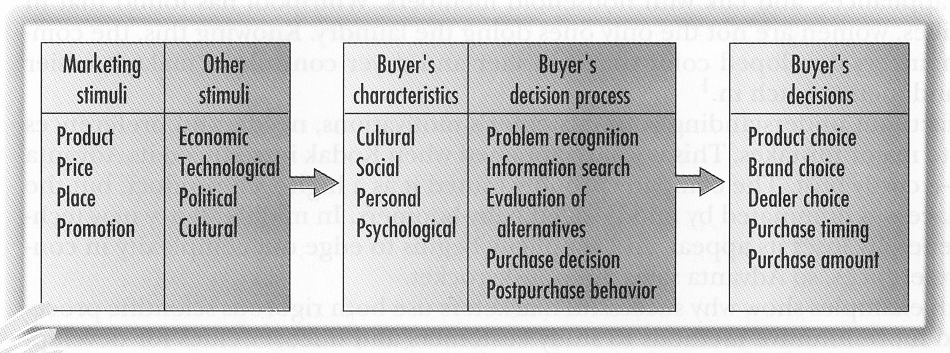
The way of life embraced by a client is profoundly reliant on the client’s experience (Kotler 2001, p. 87). Another essential element that impacts the conduct of the client is the financial level of the client. Individuals who fit in with the same financial class ordinarily have the same needs and the same method of conduct; these likewise incorporate the purchasing conduct of the client (Kotler et al. 1999). The conduct of the client is broadly influenced by society. Society comes from the client’s rehashed association with the general public. Components like the conduct or the qualities are essential in this viewpoint. Clients have an elevated standard in terms of the nature of the administration and the estimation of the administration in an eatery.
Eateries, along these lines, have a more noteworthy part to play in keeping up a particular level of worth and quality to draw in clients from all kinds of different backgrounds (Hassan & Mall 2004, p. 96). In times of financial emergencies, clients will be pulled into aggressive pricing of items and services. A client whose desire is left hanging is thought to be disappointed. Also, when the desires of the client have been surpassed, the client will be exceedingly pleased and will share his/her sure involvement with a gathering of different companions (Kotler, Bowen & Makens 1998, p. 179; Greenbaum 1998, p. 43). As indicated by studies by different researchers, the capacity to comprehend the conduct of the client is delineated by the feasting events of the client. The eating event of the client is vital because of the way that the desire of the purchaser to eat out is animated. This will result in distinctive practices of the clients (Kivela, Inbakaran & Reece 2000, p. 36).
Eating event by the client can be separated into three, for example, the client can choose to eat alone, or with a companion, or with a gathering of companions (Kim 2000, p. 63). These three illustrations result to distinctive criteria in selecting the suitable eatery. Different studies likewise uncover that the choices of the clients to pick an eatery rely on upon different events. Case in point, one may require an eatery for a cosy supper, or birthday gathering, or a business lunch, or a family day out (June & Smith 1987, p. 23). Demographic properties of the client, for example, the age, sexual orientation, occupation, and level of salary likewise assume an essential part in affecting the purchasing conduct of the client. The sorts of administrations required by a client will change concerning the diverse periods of his/her lifetime. What’s more, the occupation and the level of pay additionally impact the purchasing choices of the client (Mill 2007, p. 43). Clients with a larger amount of salary will normally decide to eat in extravagant eateries while the ones with a lower wage level will be agreeable in customary eateries.
Importance of the eatery decision components
Numerous analysts have revealed that due to the quick paced nature of the food service industry, it is exceptionally crucial for the eatery proprietors have a reasonable comprehension of the different needs of the clients and embrace procedures went from drawing in numerous clients and holding the ones they as of now have (Miller 1993, p. 51; Greene 2003; Kim & Geistfeld 2003, p. 18). Given the way that there are restricted competitive assets, eatery proprietors ought to rush their choice making process and go for fulfilling clients. A fulfilled client is an exceptionally cheerful client. The client will make the eatery his/her top decision (Kim 2000, p. 49; Hoffman & Bateson 2001, p. 26). At the point when numerous clients have issues with an eatery, the picture of the eatery will be spoiled and it will lose clients subsequently.
The decision of a client is affected by the choices of foodstuffs, the cost of the nourishment, and the nature of the service. A lot of clients are completely fulfilled by the eatery if the costs are reasonable and the sustenance quality is great. The clients will have a justifiable reason motivation to return to the eatery and even prescribe the eatery to a companion (Auty 1992, p. 327). A lot of studies have brought up the way that food quality is exceedingly associated as per the general inclination of the client. Then again, different studies have indicated the way that service quality is exceptionally connected as per the general inclination of the client (Johns & Pine 2002, p. 132; Josiam & Monteiro 2004, p. 22). Clients, along these lines, settle on their decisions in accordance with the elements of sustenance quality and service quality. It is crucial for eatery proprietors have a reasonable picture of what the client expects (Kivela, Inbakaran & Reece 2000, p. 36). The buyers’ decision on the nature of a service is altogether different from their decisions with respect to picking merchandise or items. This is on the grounds that administrations are considerably more unique in relation to things.
Merchandise is substantial and can be touched while administrations are not unmistakable. Products are perishable; service is not (Kotler et al. 1999). These, along these lines, challenge the clients when looking at services and items. The choice making process of the customers is likewise influenced by the impact of others. A client can choose to pick a specific food outlet in light of the fact that his/her companions ordinarily visit there. The clients ordinarily have a propensity for trading thoughts with their companions in regards to new food outlets that have come up keeping in mind the end goal to get their recommendation. At the point when a sustenance outlet is respected exceptionally by companions, the client is well on the way to lean toward it. Promoting likewise impacts the choice making procedure of the clients. It creates more mindfulness about the item since it is the greatest type of correspondence (Aaker 1991, p. 65). Different components incorporate the bundling of the service and the comfort of the administration (Bailey & Earle 1993, p. 262).
Summary
This section evaluated the hypotheses both experimental and hypothetical that are firmly connected with comprehension why clients are propelled to visit a specific sustenance outlet again and again. Numerous clients are respected to be judicious purchasers. They first need to have information about the item, create and state of mind before continuing to make the buy. Their choices to buy are affected by both interior and exterior variables. The main element that rouses the clients is the nature of the sustenance or administration. The buyers, in this way, give careful consideration to the service quality that is accessible. Ennew and Binks in their study arranged the conduct of the customers into two, for instance, subjective buyer conduct, and shopper conduct attached to the purchaser’s. The contrast between the two is that psychological purchasers are normal while experienced shoppers have an individual attachment with the item or the administration. Accordingly, they portrayed four clear attributes of a purchaser. The attributes are coherent, instructed, blameless, and social (Ennew & Binks 1996, p. 221).
The clients likewise regularly take a gander at the cost of the item or administration as another element that impacts their choices to pick a sustenance outlet. Cost and quality are integral, in that, the most astounding quality pulls in the most elevated costs and the other way around. Numerous fast food outlets have brought down their costs to upgrade their focused edge in the business; along these lines, diminishing their monetary dangers (MacDonald & Sharp 2000, p. 10). The conduct of the client is broadly influenced by society. Society originates from the clients rehashed association with the general public. Components like the conduct or the qualities are critical in this viewpoint. The way of life embraced by a client is exceptionally subject to the client’s experience (Kotler 2001, p. 87).
Research Methodology
The methodology is the process of instructing the ways to do the research. It is, therefore, convenient for conducting the research and for analysing the research questions. The process of methodology insists that much care should be given to the kinds and nature of procedures to be adhered to in accomplishing a particular set of procedures or an objective (Wagner 2009). This part includes the research design, the sample and the methods that were used in gathering information. It also contains the data analysis methods, validity and reliability of data and the limitation of the study.
Quantitative and Qualitative Approach
Quantitative Approach
Quantitative examination methodology alludes to the utilization of factual procedures, scientific systems, and computation strategies to exactly break down information (Wagner 2009). The quantitative approach goes for using the scientific and factual speculations and models to break down the information. The quantitative system approves the speculations and conclusions that have been drawn from the subjective procedure. The experimental systems and procedures that are used in quantitative philosophy include inferring models and hypotheses, and outlining instruments for information social event.
Qualitative Approach
The qualitative methodology is, for the most part, concerned with the human thought processes and the explanations for such intentions (Bryman & Cramer 1999). The principle addresses that accompany subjective methodology are “the reason?” and “how?” notwithstanding ‘what?’, “where?” and ‘when?’. Concerning this, a specialist using the subjective methodology will have a tendency to utilize littler examples as opposed to bigger specimens. Subjective approach entirely produces just data that applies to the assigned contextual analysis; any extra data is dealt with as estimates. When speculations are drawn from a subjective methodology, they are tried through the quantitative methodology.
Advantages and disadvantages of primary research
Primary research is relevant for categorizing the observations or variables, examining the variables and generating statistical representations to analyse the observations. A researcher who utilizes the primary research design has a predetermined knowledge of what to expect. Also, the researcher employs data collection instruments like questionnaires or other relevant data collection equipment. The kind of data handled through primary research is mainly in numerical or statistical format. A strong feature of the primary research is that it is the most efficient design to test hypotheses. Its limitation is that the relevant details of the variables or observations may be overlooked (Wagner 2009).
On the other hand, primary research does not give a full detail in terms of the description of the research process. Unlike qualitative research, the researcher has no idea of what results to expect because he/she mainly relies on observations. Primary research approach consumes a lot of time and demands many resources in terms of money and expertise (Wagner 2009).
Research Design
There are three types of research design: exploratory research, descriptive research, and causal research (Wagner 2009). Exploratory research mainly explores the nature of the problem to generate conclusions. In this situation, the specialist is in an amazing position to comprehend the issue under scrutiny. The stream of exploratory examination includes distinguishing the issue and looking to locate the proper arrangements and new thoughts. The exploratory examination is basically relevant in circumstances where the structure of the exploration issue is not unmistakable. The meeting is a decent case of the strategies that will be utilized to accumulate data in this sort of exploration.
This sort of investigation is utilized when the specialist hopes to recognize the different watched actualities in a specimen or a populace. Additionally, the enlightening examination is every now and again utilized by the scientist when the analyst has a former comprehension of the issue under scrutiny. Causal exploration is the sort of examination whereby there is a reasonable structure of the exploration issue. For this situation, the analyst is intrigued to investigate the reason impact relationship. The reasons are recognized, broke down and the degree of the impacts is evaluated.
Questionnaire Survey
Surveys are a pre-planned arrangement of inquiries that require the respondents to record their responses more often than not in firmly characterized options. Polls can be managed to the respondents either via mail or by and by the specialist. Before outlining a poll, there are three standards to pay consideration on, these standards incorporate standards of wording, standards of estimation, and the general set up of the survey. The guideline of content involves the substance and reason for the inquiries, for example, the specialist needs to comprehend the way of variables to be tapped. In case a variable is subjective, for example, client maintenance where a respondent’s conviction, discernments, and states of mind are to be measured, the inquiries ought to draw the measurements and components of the ideas.
Additionally, where target variables, for example, age and pay are tapped, a solitary direct question would be proper. The wording and dialect are different components of the rule of content, for example, the dialect of the survey ought to inexact the level of comprehension of respondents. Thus, the decision of words ought to rely on upon the level of instruction of the respondents.
The guideline of estimation envelops the standards to be taken after to guarantee that the information gathered is fitting to test the speculations. These standards incorporate order, which involves the conformity of negative inquiries to end up positive issues, coding, utilizing scales and scaling methods, and dependability and legitimacy. Dependability demonstrates how steady and reliable the instrument taps the variable. The general set up of the survey envelops the prologue to respondents, length of the poll, directions for finishing and the general appearance of the survey (Amemiya 1981).
Data Collection
This research mainly relied on primary sources; questionnaires were used to collect the data. Primary data were preferred since it is reliable, convenient and comfortable. The data were collected by conducting a pre-test of the questionnaires. The surveys were issued to a specimen of 200 respondents; just 169 polls were filled effectively. The information for the study was gathered from the clients of the fast food outlet under study. The clients were utilized in light of the fact that their profiles fit the setting of this study. Hence, the clients were an astounding decision in light of the fact that a hefty portion of them had the inn experience. The members’ reactions were treated with much privacy.
Ethical Considerations
In this exploration, the researcher is speculated to have considered all parts of the ethical issues. The moral issues should be brought up in the proposition of the examination. The research ought to be composed and embraced in a manner that it encourages quality and trustworthiness. The study staff should be educated of the reason, systems and the utilization of the exploration. Moreover, they should look into the needs to regard the secret data and the obscurity of the respondents. The harm that may be transferred to the participants must be avoided. With respect to this study, the information gathered had to be confidential and not reported to others. The members were obliged to partake in the examination wilfully, and they had the privilege of not answering questions that they viewed as uncomfortable. The researcher needed to regard the secrecy of the respondents.
Limitations of the study
The cost of conducting the survey was expensive. Also, there were instances when the respondents provided false and incorrect responses. The process of data collection was time-consuming and tedious. In addition, a couple of delegates were reluctant to offer some information that was private and hazardous in the hands of their opponents. This meant a phenomenal test in the examination as the scientist expected to take more opportunity to discover labourers who might enthusiastically give out adequate information.
Findings, Data Analysis and Interpretation
This segment covers the examination of the information, presentation and understanding. The outcomes were dissected utilizing SPPS, ANOVA, relapse and connection examination.
Characteristics of the sample
In order to understand the demographic information about the participants, the distribution of gender, age, education level, income, and times stayed in the Fast food outlet A are summarized in the following sections.
Gender
Table 4.1 Gender distribution.
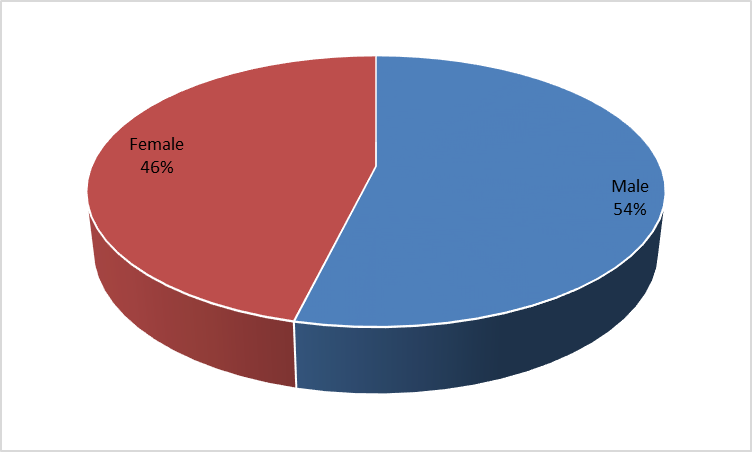
The distribution of gender is summarized in Table 4.1 and Figure 4.1, according to the results; there are 78 females and 91 males, composed 46.2% and 53.8% of the sample respectively.
Age
Table 4.2 Age distribution.
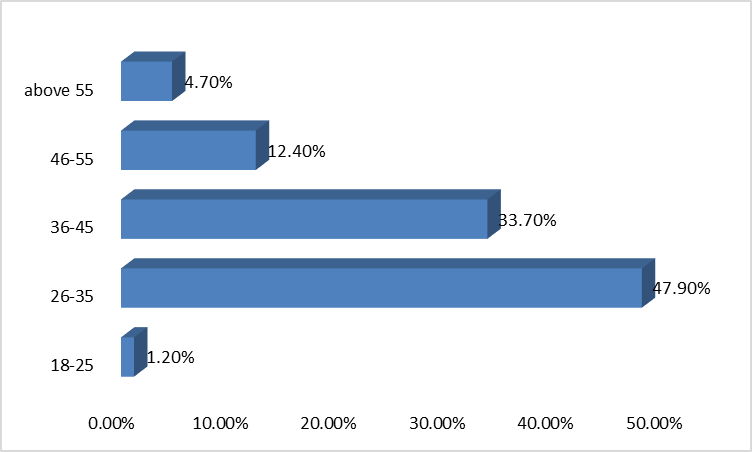
The dispersion of age is compressed in Table 4.2 and Figure 4.2 above. As per the outcomes, there are 47.9% of the members matured somewhere around 26 and 35, which is the biggest extent, trailed by members matured somewhere around 36 and 45, made 33.7% out of the example, and members matured somewhere around 46 and 55, accounted 12.4% of the specimen. At last, members matured over 55 or somewhere around 18 and 25 made 4.7% and 1.2% out of the example separately.
Education level
Table 4.3 Education distribution.
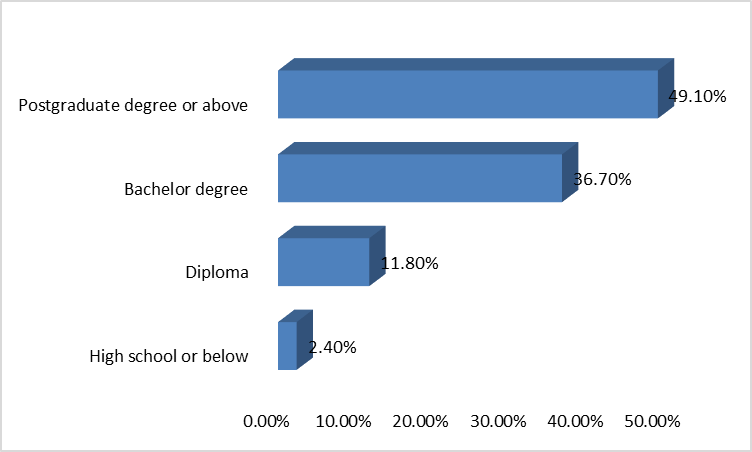
As far as the training level, almost 50% of the members (49.1%) have a postgraduate degree or above, which is the biggest extent, trailed by members who have a four year certification, made 36.7% out of the specimen, and members who have a confirmation, made 11.8% out of the example. There are just 2.5% of the members have secondary school or beneath degree.
Income
Table 4.4 Income distribution.
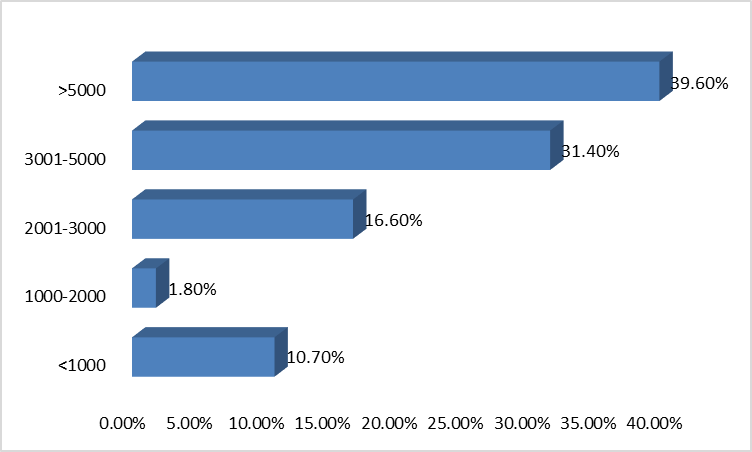
Concerning pay of the members, 39.6% of the members show that they have wage over 5000, which is the biggest extent, trailed by members who have wages around 3001 and 5000, made 31.4% out of the specimen, and members who have wages somewhere around 2001 and 3000, made 16.6% out of the example. There are 10.7% of the members have salary beneath 1000 and 1.8% of the members have wages somewhere around 1000 and 2000.
Times to stay in the Fast food outlet A
Table 4.5 Times to stay in a Fast food outlet A.
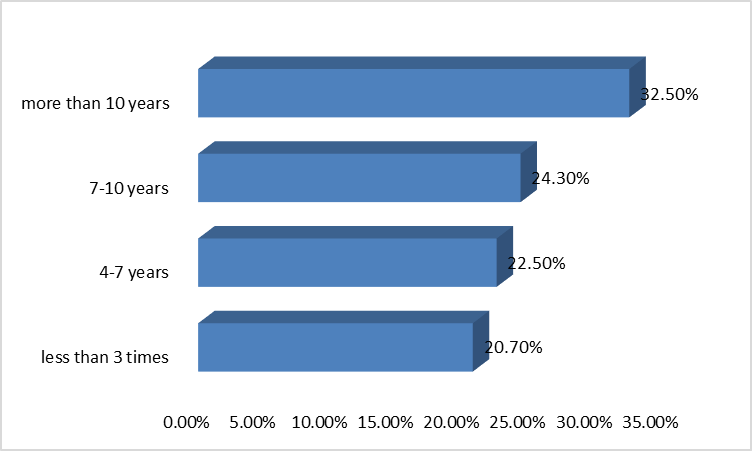
Table 4.5 and Figure 4.5 above summarized the times the participants have stayed in the Fast food outlet A. According to the results, 32.5% of the participants have stayed more than 10 times, which is the largest proportion, followed by participants who have stayed between 7 and 10 times, composed 24.3% of the sample, and participants who have stayed between 4 and 7 times, composed 22.5% of the sample. In addition, there are 35 participants have stayed Fast food outlet A less than 3 times, comprised 20.7% of the sample.
Reliability Analysis
The unwavering quality examination is frequently used to assess whether the numerous instrument things are measuring the same variable or idea. In SPSS, the Cronbach’s Alpha quality is typically used to quantify the unwavering quality of the different variables. The base prerequisite for the estimation of Cronbach’s Alpha is 0.7 to guarantee that the things are inside predictable and dependable. In the exploratory study, the Cronbach’s Alpha estimation of 0.6 can likewise be acknowledged. In this study, the various measurement items are adopted from previous studies, thus, the minimum value is set at 0.7.
The corrected-item total correlation (CITC) is also included to evaluate the reliability of the individual item. If the CICT is below 0.5, then the item cannot reliably measure the corresponding variable and should be excluded from further analysis (Hair, Bush & Ortinan 2000). The Cronbach’s Alpha if item deleted indicate whether the Cronbach’s Alpha value is decreased or increased after excluded this item. Thus, if this value is above the Cronbach’s Alpha value for the variable, the item should then be excluded from further analysis. Table 4.6 summarizes the results.
Table 4.6 Reliability Analysis for Variables.
As indicated by the outcomes, the Cronbach’s alpha estimation of Fast nourishment outlet A learning, ecological concern, reasonable value, administration quality, hotel offices, subjective standards, and client maintenance are 0.836, 0.817, 0.761, 0.739, 0.898, 0.833, and 0.837, which are all over the base prerequisite of 0.7. What’s more, the CICT for individual things are all over the base necessity of 0.5 and the Cronbach’s Alpha if erased for individual things are all beneath the Cronbach’s Alpha quality. These outcomes exhibit that these things are inside predictable and dependable, and can be utilized for further examination.
Frequency analysis
Fast food outlet A knowledge frequency analysis
Table 4.7 Fast food outlet A knowledge frequency analysis.
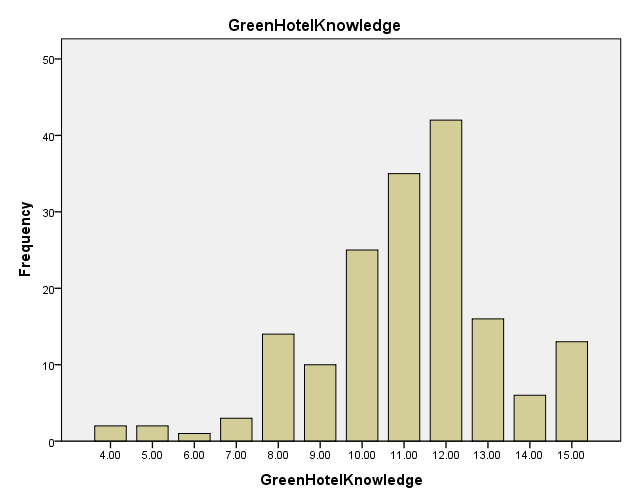
As can be seen from Table 7 and Figure 7, more than half of the participants are familiar with the Fast food outlet A. There are 52.1% of the participants indicate that “Compared to the average person, I am familiar with the hotel’s environmental policies” and 46.2% of the participants indicate that “Compared to my friends, I am familiar with hotels’ green programs”. From the total score of these 3 items measuring Fast food outlet A knowledge, a large group of participants have a score of 11 or 12. To gain a clearer picture of the participants’ Fast food outlet A knowledge, the items measuring Fast food outlet A knowledge were aggregated. The aggregated mean value was 3.69, suggesting that participants have medium level knowledge of the Fast food outlet A.
Environmental concern frequency analysis
Table 4.8 Environmental concern frequency analysis.
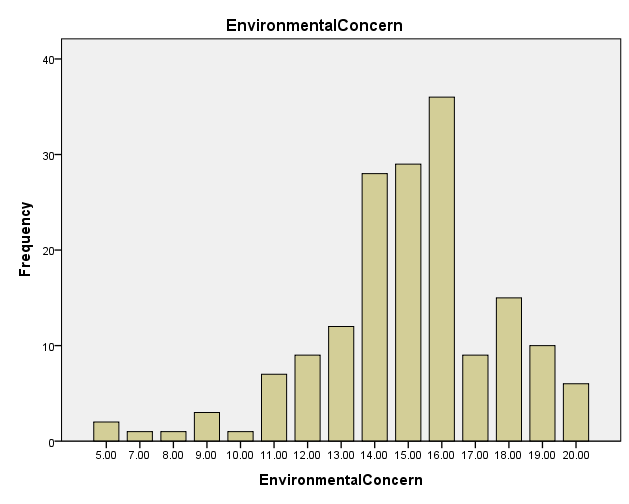
Table 4.8 shows the overall responses to the environmental concern among participants. According to the results, the mean value of all measurement items was between 3 and 4. Thus, the participants’ attitude, concern was at a medium level. By analysing the frequency, it can be seen that more than half of the participants have expressed their concern regarding the environmental problem. With a specific end goal to pick up a more point by point photo of the level of natural concern, the total mean score was grouped into three levels: low (beneath 2), medium (2-4), and high (4-5). The total mean score was 3.76, proposing a medium level of ecological concern. The general scores of the things measuring natural concern were outlined, and it is found that the extent was 16, with scores running from 5 to 20. Most of the members have a general score somewhere around 14 and 16.
Fair price frequency analysis
Table 4.9 Fair price frequency analysis.

Table 4.9 summarized the frequency analysis for items measuring fair price. According to the results, the majority of the participants agree or strongly agree that “This Fast food outlet A offers a good service that is worth its rice”, “The prices are acceptable”, and “Compared to the price of other hotels, this Fast food outlet A charge fairly”. The aggregated mean value of fair price is 3.98, nearly 4, suggesting that participants have a positive attitude towards the fair price of the Fast food outlet A. Figure 4.9 summarized the score of the items measuring fair price. As can be seen from the results, the majority of the score ranged between 10 and 15, indicating a relatively higher level positive attitude towards fair price.
Service quality frequency analysis
Table 4.10 Service quality frequency analysis.
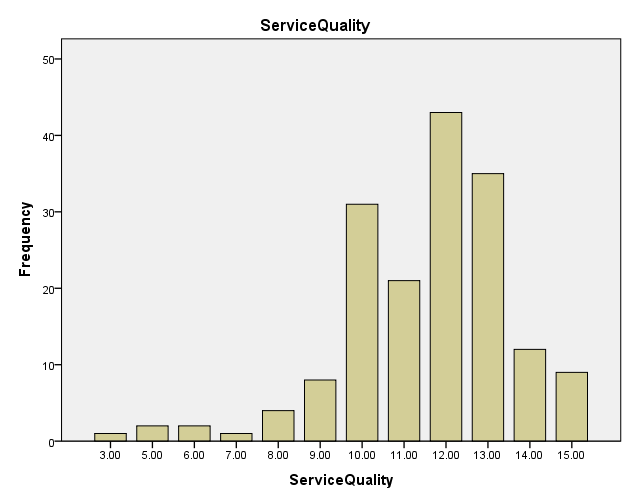
Table 4.10 summarized the frequency analysis for items measuring service quality. According to the results, more than half of the participants agree or strongly agree that “The staffs are reliable and helpful”, “The staffs are professional”, and “The staff respond to my inquiries quickly”. The aggregated mean value of fair price is 3.85, suggesting that service quality is at medium to high level. Figure 4.10 summarized the score of the items measuring service quality. As can be seen from the results, the majority of the score ranged between 10 and 13, which also indicate a medium to high level service quality perception.
Hotel facilities frequency analysis
Table 4.11 Hotel facilities frequency analysis.
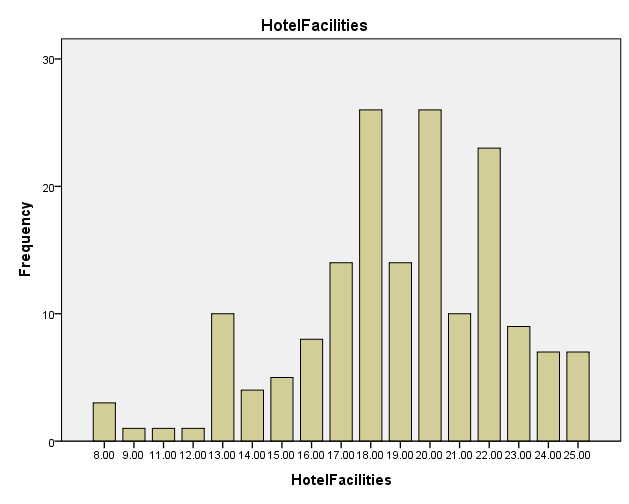
Table 4.11 summarized the frequency analysis for items measuring hotel facilities. According to the results, more than half of the participants agree or strongly agree that “The hotel temperature is comfortable”, “The hotel environment is comfortable”, “The hotel environment is clean”, “The hotel lighting is appropriate”, “The decoration of the hotel is comfortable”. The aggregated mean value of fair price is 3.79, suggesting that hotel facilities are at medium to high level. Figure 4.11 summarized the score of the items measuring hotel facility. As can be seen from the results, the majority of the score ranged between 18 and 22, which also indicate a medium to high level hotel facility perception.
Subjective norms frequency analysis
Table 4.12 Subjective norms frequency analysis.
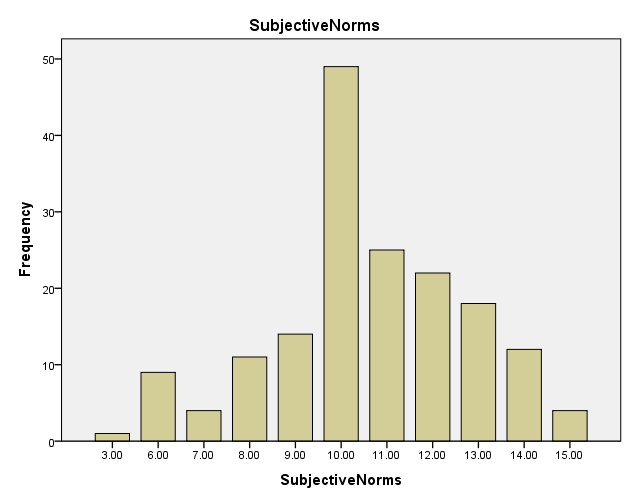
Table 4.12 summarized the frequency analysis for items measuring subjective norms. According to the results, less than half of the participants agree or strongly agree that “Most people who are important to me think I should use the Fast food outlet”, “Most people who are important to me would want me to use the Fast food outlet A”, “People whose opinions I value would prefer that I use the Fast food outlet A”. The aggregated mean value of fair price is 3.53, suggesting that the subjective norms are at medium level. Figure 4.12 summarized the score of the items measuring subjective norms. As can be seen from the results, the majority of the score ranged between 10 and 11, which also indicate medium level subjective norms.
Customer retention frequency analysis
Table 4.13 Customer retention frequency analysis.
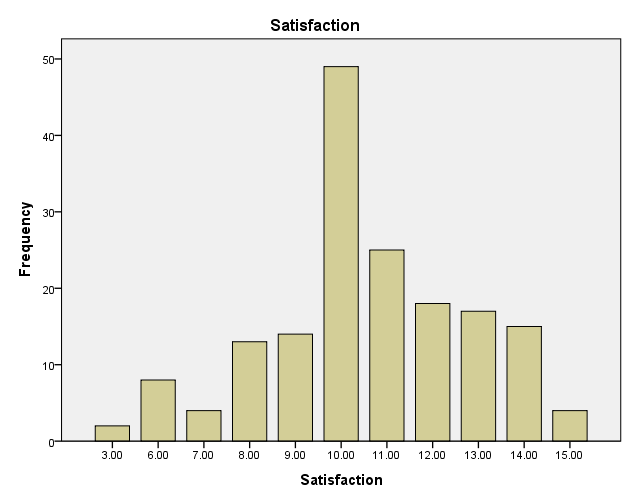
Table 4.13 summarized the frequency analysis for items measuring customer retention. According to the results, nearly half of the participants agree or strongly agree that “Overall, I am satisfied with experience in this Fast food outlet A”, “I am glad to use the Fast food outlet A again in the future”. The aggregated mean value of fair price is 3.52, suggesting that the subjective norms are at medium level. Figure 4.13 summarized the score of the items measuring customer retention. As can be seen from the results, the majority of the score ranged between 10 and 11, which also indicate a medium level customer retention.
Correlation analysis
Correlation between Fast food outlet A knowledge and Customer retention
In order to check the correlation between Fast food outlet knowledge and customer retention, a scatter plot was initially made with a specific end goal to guarantee that there was not an infringement of the presumptions of ordinariness, linearity and homoscedasticity among the information. As found in Figure 14 underneath, there is an in number, positive connection between the variables of Fast nourishment outlet information and client maintenance and the information is ordinarily circulated.

After inspecting a positive correlation between Fast food outlet knowledge and customer retention, a Pearson product-moment connection coefficient was completed to dissect the relationship concerning Fast food outlet A knowledge and customer retention. The results are shown in table 4.14 above. The correlation value below 0.3 indicates low level correlation; the correlation value between 0.3 and 0.6 indicates medium level correlation, while the correlation value above 0.6 indicates higher level correlation. The results are in Table 4.14. There was a slight direct connection between Fast food outlet knowledge and customer retention, with a correlation value of 0.373, which is significant at 0.01 levels, indicating that higher levels of Fast food outlet knowledge is associated with higher levels of customer retention.
Table 4.14 Correlation between Fast food outlet A knowledge and Customer retention.
Correlation between Environmental Concern and Customer retention
Keeping in mind the end goal to check the connection between Fast food outlet’s information and client maintenance, a scramble plot was made. As found in Figure 4.15 underneath, there is an in number, positive connection between the variables of natural concern and client maintenance and the information is regularly circulated.

In the wake of examining a positive connection between natural concern and client maintenance, a Pearson product-moment connection coefficient was completed to break down the relationship between ecological concern and client maintenance. The outcomes are demonstrated in Table 15 underneath. As can be found in Table 15, there was a medium positive relationship between ecological concern and client maintenance, with a connection estimation of 0.313, which is critical at 0.01 level, showing that more elevated amounts of natural concern is connected with larger amounts of client maintenance.
Table 4.15 Correlation between Environmental Concern and Customer retention.
Correlation between Fair price and Customer retention
To check the relationship between a reasonable cost and client maintenance, a scatter plot was made. As found in Figure 16 beneath, there is an in number, positive connection between the variables of reasonable cost and client maintenance and the information is regularly conveyed.

In the wake of reviewing a positive connection between a reasonable cost and client maintenance, a Pearson product-moment connection coefficient was completed to dissect the relationship between reasonable cost and client maintenance. The outcomes are demonstrated in table 16 underneath. As can be seen from this table, there was a medium positive connection between a reasonable cost and client maintenance, with a relationship estimation of 0.412, which is critical at 0.01 level, showing that more elevated amounts of reasonable cost is connected with larger amounts of client maintenance.
Table 4.16 Correlation between Fair price and Customer retention.
Correlation between Service quality and Customer retention
With a specific end goal to check the connection between administration quality and client maintenance, a disperse plot was made. As found in Figure 4.17 underneath, there is an in number, positive connection between the variables of administration quality and client maintenance and the information is regularly conveyed.
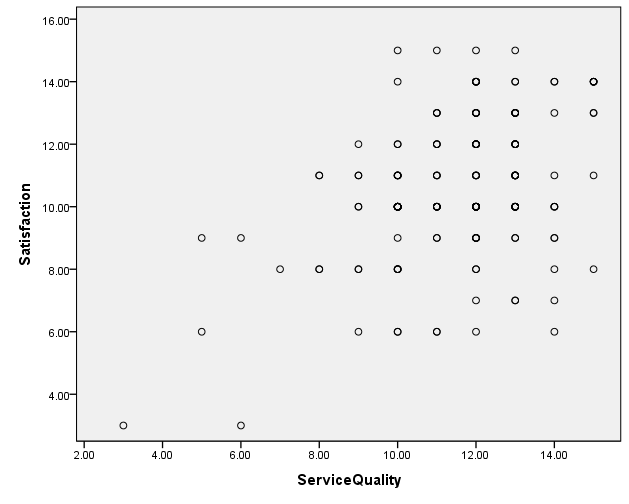
In the wake of assessing a positive connection between administration quality and client maintenance, a Pearson product-moment connection coefficient was done to break down the relationship between administration quality and client maintenance. The outcomes are demonstrated in Table 4.17 underneath. As can be seen from this table, there was a medium positive relationship between administration quality and client maintenance, with a connection estimation of 0.409, which is critical at 0.01 level, demonstrating that larger amounts of administration quality is connected with more elevated amounts of client maintenance.
Table 4.17 Correlation between Service quality and Customer retention.
Correlation between Hotel facilities and Customer retention
So as to check the connection between the hotel offices and client maintenance, a disseminate plot was made. As found in Figure 4.18 underneath, there is an in number, positive connection between the variables of the hotel offices and client maintenance and the information is typically circulated.
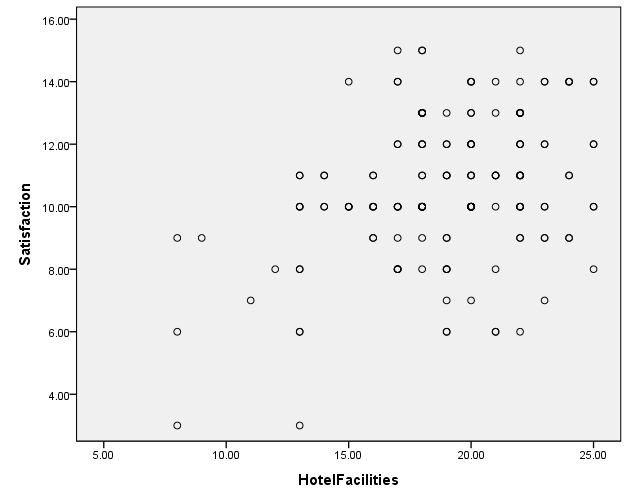
After inspecting a positive correlation between hotel facilities and customer retention, a Pearson product-moment connection coefficient was done to break down the relationship between lodging offices and client maintenance. As can be seen from this table, there was a medium positive correlation between hotel facilities and customer retention, with a correlation value of 0.455, which is significant at 0.01 level, indicating that higher levels of hotel facilities is associated with higher levels of customer retention.
Table18. Correlation between Hotel facilities and Customer retention.
Correlation between Subjective norms and Customer retention
In order to check the correlation between subjective norms and customer retention, a scatter plot was created. As found in Figure 4.19 beneath, there is an in number, positive connection between the variables of subjective standards and client maintenance and the information is regularly disseminated.
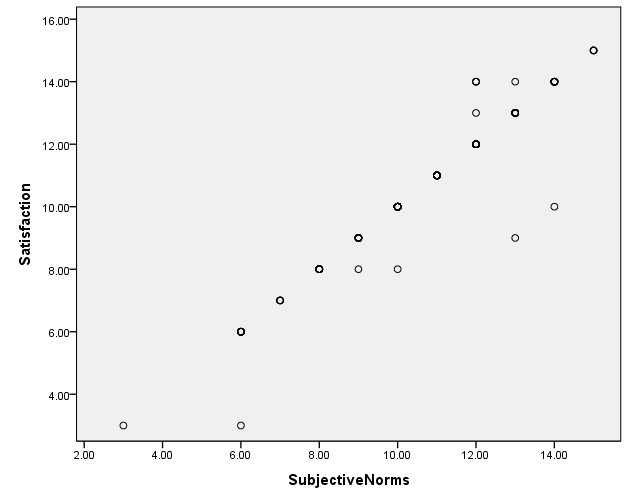
In the wake of investigating a positive connection between subjective standards and client maintenance, a Pearson product-moment connection coefficient was completed to examine the relationship between subjective standards and client maintenance. The outcomes are indicated in table 19 underneath. As can be seen from this table, there was an in number positive connection between subjective standards and client maintenance, with a relationship estimation of 0.765, which is noteworthy at 0.01 level, showing that larger amounts of subjective standards is connected with more elevated amounts of client maintenance.
Table 4.19 Correlation between Subjective norms and Customer retention.
Regression analysis
Regression is a measurement procedure for evaluating the connections among variables. All the more particularly, regression investigation is ordinarily used to see how the change of autonomous variables can influence the change of ward variables (Wagner 2009). The correlation investigation above demonstrated that there are connections between subjective standards, lodging offices, Fast sustenance outlet An information, reasonable value, administration quality, natural concern and client maintenance. With a specific end goal to discover how these variables impact client maintenance and which one has the greatest effect, the numerous straight relapse is utilized.
Table 4.20 Model Summary.
The Adjusted R Square is 0.536, which means that the independent variables of subjective norms, hotel facilities, Fast food outlet A knowledge, fair price, service quality, and environmental concern can explain 53.6% of the variance of customer retention.
Table 4.21 ANOVA.
By condensing the ANOVA table, it can be said that the autonomous variables of subjective standards, hotel offices, Fast sustenance outlet An information, reasonable value, service quality, and natural concern can foresee the reliant variable of client maintenance at a hugeness of 0.01, by considering F=411.961.
Table 4.22 Coefficients.
Table 4.22 gives the results. The results reveal an absence of collinearity because the VIF values for all independent variables are less than 10 and the Tolerance value for all variables are above 0.1. It is found that subjective norms, hotel facilities, Fast food outlet A knowledge, fair price, service quality, and environmental concern can significantly impact customer retention, with sig values all less than 0.05. Specifically, subjective norms have the biggest impact on customer retention, with a standardized coefficient value of 0.437, followed by hotel facilities, with a standardized coefficient value of 0.424 and fair price, with a value of 0.334. The environmental concern has the smallest impact on customer retention, with a standardized coefficient value of 0.212.
Conclusion and Recommendations
This part shows the synopsis of the discoveries and examination of the outcomes in understanding to the goals of this study. At last, the section contains the conclusions and suggestions.
Conclusion
An understanding about the conduct of the customers is extremely helpful in getting ready for the buyer based administrations. Accordingly, it is less demanding to bring up the impression of the purchasers toward a specific item. Customer conduct can, along these lines, be clarified as the methods that shoppers seek after when trying to purchase or inspect an item or an administration that is intended to experience their cravings. Turley and Moore sorted the conduct of the buyers into two. These include subjective customer conduct and shopper conduct fixing to the purchaser’s experience-arranged. The contrast between the two is that psychological buyers are judicious while experienced purchasers have an individual connection to the commodity or the service. It is a conviction that when a client is very fulfilled by an eatery, the chances are that the client will prescribe the eatery to no less than five companions. Subsequently, they portrayed four distinctive qualities of a customer. The attributes are consistent, taught, guiltless, and social. Intelligent shoppers will need to have a decent learning about the item or administration in addition to the included components before making the move to purchase it.
By diving into the data about the item, an affiliation or disposition between the customer and the item/administration is produced. It is this affiliation/state of mind that will figure out if the purchaser will purchase the item/benefit or not. In connection with this study, numerous clients are voyagers; they would wish to know all the more around an eatery and build up a state of mind/connection to the eatery before going to eat out. Intelligent buyers can, in this way, be abridged in three stages, for example, having knowledge, developing an attitude and executing the action of purchase.
According to the results, more than half of the participants agree or strongly agree that “The staffs are reliable and helpful”, “The staffs are professional”, and “The staff respond to my inquiries quickly”. This indicates a medium to high-level service quality perception. Also, more than half of the participants agree or strongly agree that “The hotel temperature is comfortable”, “The hotel environment is comfortable”, “The hotel environment is clean”, “The hotel lighting is appropriate”, “The decoration of the hotel is comfortable”. This suggests that hotel facilities are at medium to high level. Less than half of the participants agree or strongly agree that “Most people who are important to me think I should use the Fast food outlet A”, “Most people who are important to me would want me to use the Fast food outlet A”, “People whose opinions I value would prefer that I use the Fast food outlet A”. The majority of the score ranged between 10 and 11, which also indicate medium level subjective norms.
Recommendations
This study provides information that is adequate to improve and protect the physical appearance of fast food outlets to enable it to be in a competitive position. Moreover, the ease of accessibility to the food outlets should be improved so as to give an easy time for the customers from all walks of lives to access. The dining facilities and other social amenities should be upgraded so that they can be up to standard and fit the specifications and the requirements of the customers.
References
Aaker, D 1991, Managing brand equity capitalizing on the value of a brand name, Free Press, New York.
Amemiya, T 1981, ‘Qualitative response model: A survey’, Journal of Economic Literature, vol. 19 no. 1, pp. 1485-1536.
Angelo, R & Vladimir, N 2001, Hospitality today: An introduction, Educational Institute of the American Hotel & Lodging Association, Lansing MI.
Asp, H 1999, ‘Factors affecting food decisions made by individual consumers’, Food Policy, vol. 24 no. 2, pp. 287-294.
Auty, S 1992, ‘Consumer choice and segmentation in the restaurant industry’, The Service Industries Journal, vol. 12 no. 3, pp. 324-339.
Bailey, R & Earle, M 1993, Home cooking to takeaways: Changes in food consumption in New Zealand during 1880-1990, Massey University, Palmerston North, New Zealand.
Bailey, R & Tian, G 2002, ‘Cultural understanding and consumer behaviour: A case study of Southern American perception of Indian food’, Journal of American Academy of Business, vol. 2 no. 1, pp. 58-65.
Belch, G & Belch, M 2004, Advertising and Promotion: An Integrated Marketing Communications Perspective, McGraw-Hill, New York.
Bell, J 2005, Doing your research project: a guide for first-time researchers in education, health and social science, Open university press, Maidenhead.
Bennett, R & Rundle-Thiele, S 2002, ‘A Comparison of Attitudinal Loyalty Measurement Approaches’, Journal of Brand Management, vol. 9, no. 3, pp. 193-209.
Berkman, W, Lindquist, D & Sirgy, M 1996, Consumer behaviour, NTC Publishing Group, Lincolnwood, IL.
Berman, B & Evans, R 2006, Retail Management: A Strategic Approach, Prentice Hall, Upper Saddle River, NJ. Bennett
Bitner, M 1990, ‘Evaluating service encounters: The effects of physical surroundings and employee responses’, Journal of Marketing, vol. 54 no. 2, pp. 69-82.
Bitner, M 1992, ‘Services-capes: The impact of physical surroundings on customers and employees’, Journal of Marketing, vol. 56 no. 2, pp. 57-71.
Blanchard, H & Cathy, S 2002, The generosity factor: Discover the joy of giving your time, talent, and treasure, Zondervan Press, Grand Rapids.
Britton, B, Samantha, J, Chadwick, T & Terry, W 1999, ‘Rewards of Work’, Ivey Business Journal, vol. 15, no. 2, pp. 27-28.
Brookes, M 2004, Shaping culinary taste: the influence of commercial operators, Elsevier Butterworth-Heinemann, Oxford.
Bryman, A & Cramer, D 1999, Quantitative data analysis with SPSS release 8 for Windows: A guide for social scientists, Routledge, London.
Brymer, R 2002, Hospitality & tourism, Kendall/Hunt Publishing Company, Dubuque, IA.
Burnett, J & Moriarty, S 1998, Introduction to marketing communications: An integrated approach, Prentice-Hall, Upper Saddle River, NJ.
Burton, D 1982, Two hundred years of New Zealand food & cookery, Reed, Wellington, New Zealand.
Burton, S 1990, ‘The framing of purchase for services’, The Journal of Services Marketing, vol. 4 no. 4, pp. 55-66.
Cadotte, E & Turgeon, N 1988, ‘Key factors in guest satisfaction’, Cornell Hotel and Restaurant Administration Quarterly, vol. 28 no. 4, pp. 44-51.
Cheng, K 2006, ‘What consumers need from restaurants: An empirical study on different classes of restaurants in Taiwan and their customer service’, Journal of American Academy of Business, vol. 8 no. 1, pp. 156-162.
Churchill, G 1979, ‘A paradigm for developing better measures of marketing Constructs’, Journal of Marketing Research, vol. 16 no. 1, pp. 64-73.
Clark, M & Wood, C 1998, ‘Consumer loyalty in the restaurant industry: A preliminary exploration of the issues’, International Journal of Contemporary Hospitality Management, vol. 10 no. 4, pp. 139-144.
Clemes, M, Mollenkopf, D & Burn, D 2000, ‘An investigation of marketing problems across service typologies’, Journal of Services Marketing, vol. 14 no. 7, pp. 573-594.
Cowell, W 1989, The marketing of services, Heinemann, Oxford.
Dillman, A 2007, Mail and internet surveys: The tailored design method, Wiley, Hoboken, NJ.
Dittmer, P & Griffin, G 1997, Dimensions of the hospitality industry: An Introduction, John Wiley & Sons, Inc., New York.
Doyle, P 2002, Marketing Management and Strategy, Pearson Education, Harlow.
Dube, L, Renaghan, M & Miller, M 1994, ‘Measuring customer satisfaction for strategic management’, Cornell Hotel and Restaurant Administration Quarterly, vol. 35 no. 1, pp. 39-47.
Dugan, B 1994, ‘Religion and food service’, Cornell Hotel and Restaurant Administration Quarterly, vol. 35 no. 6, pp. 80-85.
Ennew, T & Binks, M 1996, ‘The impact of service quality and service characteristics on customer retention: Small business and their banks in the UK’, British Journal of Management, vol. 7 no. 3, pp. 219-230.
Finkelstein, J 1989, Dining out: A sociology of modern manners, Polity, Cambridge.
Goldman, K 1993, ‘Concept selection for independent restaurants’, Cornell Hotel and Restaurant Administration Quarterly, vol. 34 no. 6, pp. 59-72.
Greenbaum, T 1998, The handbook for focus group research, Sage, London.
Greene, H 2003, Econometric Analysis, Prentice Hall, Upper Saddle River, NJ.
Gregoire, B, Shanklin, W & Greathouse, R 1995, ‘Factors influencing restaurant selection by travelers who stop at visitor information centers’, Journal of Travel & Tourism Marketing, vol. 4 no. 2, pp. 41-49.
Hair, F, Bush, P & Ortinau, D 2000, Marketing research: A practical approach for the new millenium, McGraw Hill, Boston.
Hardy, M & Sheuy, K 2000, ‘Pension decision in changing economy: Gender, structure, and choice’, Journal of Gerontology, vol. 55 no. 5, pp. 271-277.
Hassan, M & Hall, C 2004, ‘The demand for halal food among Muslim travellers in Heung, C, Wong, Y & Qu, H 2000, ‘Airport-restaurant service quality in Hong Kong’, Cornell Hotel and Restaurant Administration Quarterly, vol. 41 no.3, pp. 86-96.
Hoffman, K & Bateson, J 2001, Essentials of services marketing: Concepts, strategies, and cases, South-Western, Ohio.
Holt, A & Quelch, T 2009, ‘How global brands compete’, Harvard Business Review, vol. 7, no. 3, pp. 68-75.
Hong, W, Thong, Y & Tam, Y 2005, ‘The Effects of Information format and Shopping task on Consumers Online Shopping Behavior: A cognitive Fit Pespective’, Journal of Management Information Systems, vol. 1, no. 1, pp. 149-184.
Hoq, Z & Amin, M 2010, ‘The Role of Customer Satisfaction to Enhance Customer Loyalty’, African Journal of Business Management, vol. 4, no. 12, pp. 2385-2392.
Hughes, R, Ginnett, R & Curphy, G 2012, Leadership: Enhancing the lessons of experience, McGraw-Hill Irwin, New York.
Jackson, H, Titz, K & DeFranco, L 2004, ‘Frequency of restaurant advertising and promotion strategies: Exploring an urban market’, Journal of Food Products Marketing, vol. 10 no. 2, pp. 17-32.
Jamali, D 2007, ‘A Study of Customer Satisfaction in the Context of a Public Private Partnership’, International Journal of Quality & Reliability Management, vol. 24, no. 4, pp. 370 – 385.
Jerisat, J 2004, Governance in a globalizing world, P2, Tampa, Florida, USA.
Jewell, D 2011, Guide to evidence-based physical therapist practice, Jones & Bartlett Learning, Ontario.
Jha, H 2014, Social research methods, McGraw-Hill Education, New Delhi.
Johns, N & Pine, R 2002, ‘Consumer behaviour in the food service industry: A Review’, International Journal of Hospitality Management, vol. 21 no. 2, pp. 119-134.
Johnson, H 2008, ‘Mental models and transformative learning: The key to leadership development’, Human Resource Development Quarterly, vol. 19, no. 1, pp. 85-89.
Jones, J & Slater, J 2003, What’s in a Name? – Advertising and the Concept of Brands, M.E. Sharpe, New York.
Josiam, M & Monteiro, P 2004, ‘Tandori tastes: Perceptions of Indian restaurants in America’, International Journal of Contemporary Hospitality Management, vol. 16 no. 1, pp. 18-26.
June, L & Smith, S 1987, ‘Service attributes and situational effects on customer preferences for restaurant dining’, Journal of Travel Research, vol. 26 no. 2, pp. 20 27.
Kandampully, J & Suhartanto, D 2000, ‘Customer Loyalty in the Hotel Industry: The Role of Customer Satisfaction and Image’, International Journal of Contemporary Hospitality Management, vol. 12, no. 16, pp. 346-351.
Kang, L & Singh, R 2006, ‘Stress at Work: An Assessment of the Magnitude of Various Organisational Stressors’, Indian Journal of Industrial Relations, vol. 42, no. 2, pp. 190-202.
Kantabutra, S & Avery, G 2010, ‘The power of vision: statements that reason at’, Journal of Business Strategy, vol. 31, no. 1, pp. 37-45.
Karamitsios, A 2013, Open Innovation in EVs: A Case Study of Tesla Motors, Routledge, New York, NY.
Keller, K 1993, ‘Conceptualizing, Measuring and Managing Customers-Based Brand Equity’, Journal of Marketing Management, vol. 57, pp. 1-12.
Kelly, T & Carvell, S 1987, ‘Checking the checks: A survey of guest-check Accuracy’, Cornell Hotel and Restaurant Administration Quarterly, vol. 28 no. 3, 63-66.
Kim, E & Geistfeld, L 2003, ‘Consumers’ restaurant choice behaviour and the impact of socio-economic and demographic factors’, Journal of Foodservice Business Research, vol. 6 no. 1, pp. 3-24.
Kim, H 2000, Ethnicity in the design of ethnic food outlets, Victoria University of Wellington, Wellington, New Zealand.
Kivela, J 1997, ‘Restaurant marketing: Selection and segmentation in Hong Kong’, International Journal of Contemporary Hospitality Management, vol. 9 no. 3, pp. 116-123.
Kivela, J, Inbakaran, R & Reece, J 2000, ‘Consumer research in the restaurant environment, part 3: Analysis, findings and conclusions’, International Journal of Contemporary Hospitality Management, vol. 12 no. 1, pp. 13-30.
Kotler, P 2001, A framework for marketing management, Prentice Hall, Upper Saddle River, NJ.
Kotler, P, Armstrong, G, Saunder, J, & Wong, V. 1999. Principle of marketing, Prentice Hall, England.
Kotler, P, Bowen, J & Makens, J 1998, Marketing for hospitality and tourism, Prentice Hall, Upper Saddle River, NJ.
Ladhari, R, Brun, I & Morales, M 2008, ‘Determinants of dining satisfaction and post dining behavioural intentions’, International Journal of Hospitality Management, vol. 27 no. 4, pp. 563-573.
Lovelock, C, Patterson, G & Walker, R 1998, Services marketing: Australia and New Zealand, Prentice-Hall, New South Wales.
Lundberg, E & Walker, R 1993, The restaurant: From concept to operation, John Wiley & Sons, New York.
MacDonald, E & Sharp, M 2004, ‘Brand awareness effect on consumer’s decision making for a common repeat purchase product’, Journal of business research, vol. 48, pp. 5-15.
Maslow, A 1970, Motivation and personality, Harper Collins, New York.
Mill, C 2007, Restaurant management: Customers, operations, and employees, Pearson Prentice Hall, Upper Saddle River, NJ.
Miller, J 1993, ‘Marketing communications’, Cornell Hotel and Restaurant Administration Quarterly, vol. 34 no. 5, pp. 48-53.
Mills, S 2000, ‘A cultural melting pot’, Restaurant USA, vol. 20 no. 4, pp. 39-40. New Zealand’, Food tourism around the world, vol. 1, pp. 81-101.
Reid, D 1983, Foodservice and restaurant marketing, CBI Publishing Company, Inc, Boston, MA.
Reynolds, K & Arnold, M 2000, ‘Customer Loyalty to the Salesperson and the Store: Examining Relationship Customers in an Upscale Retail Context’, Journal of Personal Selling and Sales Management, vol. 20, no. 2, pp. 89-98.
Reynolds, S & Valentine, D 2011, Guide to Cross-Cultural Communication, Prentice Hall publishing, Upper Saddle River.
Roth, H 2008, The challenge of the Global Brand: Handbook on Brand And Experience Management, Columbia Business School, Columbia.
Roy, S 2012, ‘Digital mastery: The skills needed for effective virtual leadership’, International Journal of e-Collaboration, vol. 8, no. 3, pp. 56-66.
Rust, T, Zeithaml, A & Lemon, N 2004, ‘Customer centred brand management’, Harvard Business Review, vol. 82, no. 4, pp. 110-118.
Saili, T, Mingli, Z & Zhichao, C 2012, ‘The Effects of Loyalty Programs on Customer Loyalty: The Mediating Role of Customer Value and the Moderating Role of Relationship Benefits’, African Journal of Business Management, vol. 6, no. 11, pp. 4295-4309.
Saxena, S 2012, ‘Challenges and Strategies for Global Branding’, Journal of Business and Management, vol. 4, no. 4, pp. 38-43.
Sekaran, U 2010, Research Methods for Business: A Skill Building Approach, John Wiley and Sons Inc., New York.
Simon, H 2007, ‘Rational decision making in business organisations’, American Economic Review, vol. 3, no. 4, pp. 123-129.
Sirdeshmukh, D, Singh, J & Sabol, B 2002, ‘Consumer Trust, Value and Loyalty in Relational Exchanges’, Journal of Marketing, vol. 66, no. 1, pp. 15-37.
Sivadas, E & Baker-Prewitt, J 2000, ‘An examination of the relationship between service quality, customer satisfaction, and store loyalty’, International Journal of Retail & Distribution Management, vol. 28, no. 2, pp. 73-82.
Srinivasana, S, Andersona, R & Ponnavolub, K 2002, ‘Customer Loyalty in E-commerce: An Exploration of its Antecedents and Consequences’, Journal of Retailing, vol. 78, no. 1, pp. 41-50.
Stecher, M & Rosse, J 2007, ‘Understanding reactions to workplace injustice through process theories of motivation: A teaching module and simulation’, Journal of Management Education, vol. 31, no. 6, pp. 781-781.
Su, Y 2004, ‘Customer Satisfaction Measurement Practice in Taiwan Hotels’, Hospitality Management, vol. 23, no. 1, pp. 397-408.
Szymanski, D & Henard, D 2001, ‘Customer Satisfaction: A Beta-Analysis of the Empirical Evidence’, Journal of the Academy of Marketing Science, vol. 29, no. 1, pp. 16-35.
Turley, L & Moore, P 1995, ‘Brand name strategies in the services sector’, Journal of Consumer Marketing, vol. 12 no. 4, pp. 42–50.
Wagner, E 2009, Using SPSS for social statistics and research methods, SAGE Publications Ltd, London, UK.
Wal, R, Van, A & Bond, C 2002, ‘Service Quality in a Cellular Telecommunications Company: A South African Experience’, Managing Service Quality, vol. 12, no. 5, pp. 323-335.
Yelkur, R 2011, ‘Customer satisfaction and service marketing mix’, Journal of professional services marketing, vol. 21, no.1, pp. 105-115.
Yin, R 2009, Case Study Research: Design and Methods, SAGE Publications, New York.
Yuen, F & Chan, S 2010, ‘The Effect of Retail Service Quality and Product Equality on Customer Loyalty’, Journal of Sata Base Marketing and Customer Strategy Management , vol. 17,no. 1, pp. 222-240.
Zineldin, M 2000, ‘Beyond relationship marketing: Technological marketing’, Marketing Intelligence & Planning, vol. 18, no. 1, pp. 9-23.
Appendices
Appendix 1: Questionnaire
Demographic Characteristics of Respondents
- Gender
- Male
- Female
- Age
- 18-25
- 26-35
- 36-45
- 46-55
- above 55
- Education level
- High school or below
- Diploma
- Bachelor degree
- Postgraduate degree or above
- How many times have you stayed in a green hotel?
- less than 3 times
- 4-7 times
- 7-10 times
- more than 10 times
- Average monthly income
- <1000
- 1000-2000
- 2001-3000
- 3001-5000
- >5000
Proposed Measurement Items for Factors
Please answer the following questions using the 5-point scale
Please answer the following questions based on your own opinion